week1
Created Friday 02 February 2018
Why sequence models
examples of seq data (either input or output):
- speech recognition
- music generation
- sentiment classification
- DNA seq analysis
- Machine translation
- video activity recognition
- name entity recognition (NER)
→ in this course: learn models applicable to these different settings.
Notation
motivating example: NER (Each word: whether the word is part of a person's name.)
x^<t>/y^<t>: t-th element in input/output sequence.X^(i): i-th training exampleT_x^(i): length of i-th training example sequence
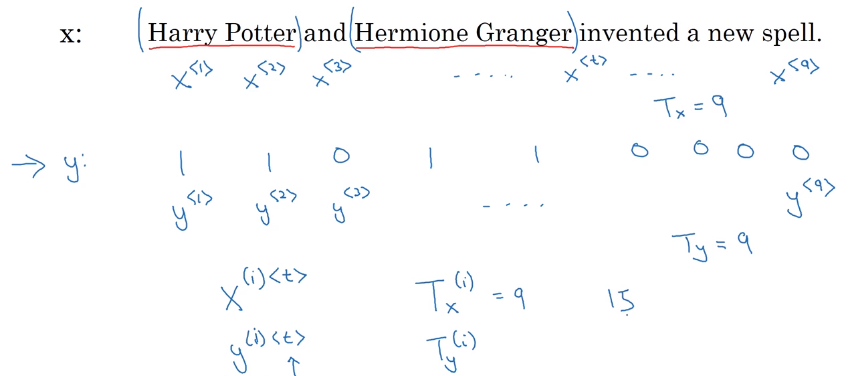
how to repr each words in a sentences (x)
- vocabulary: list of ~10k possible tokens (+"
" for unknown words) - one-hot repr for each word
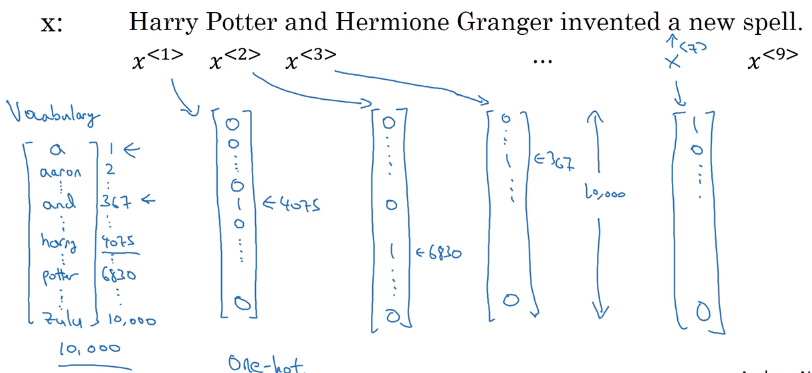
Recurrent Neural Network Model
why not a standard NN
- input/output are of different length (padding might not be a good representation)
- doesn't share features learned across different positions in text
→ using a better representation helps to reduce number of parameters.
RNN
motivation example: output length = input length
- for each input
x<t>, → feed to RNN → compute activation(hidden state)a<t>, and outputy<t>, y<t>=f(a<t>),a<t>=f(x<t>, a<t-1>), i.e. adepends on previous state and current input. - parameters
W_ax/W_aa/W_yaare shared across all time steps.
⇒ y<t> depends on x<1>...x<t>, limit: only depend on previous words ("unidirectional").
Unrolled diagram:
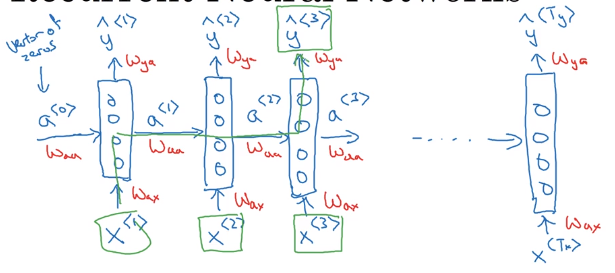
Or drawing a recurrent loop (harder to understand than unrolled version):
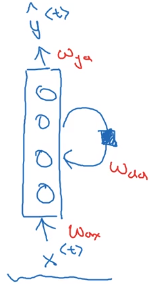
RNN Forward prop
formula to calculate a<t> and y<t>:
a
y

Simplified annotation: stack a<t-1> and x<t>, W_a = [W_aa, W_ax]
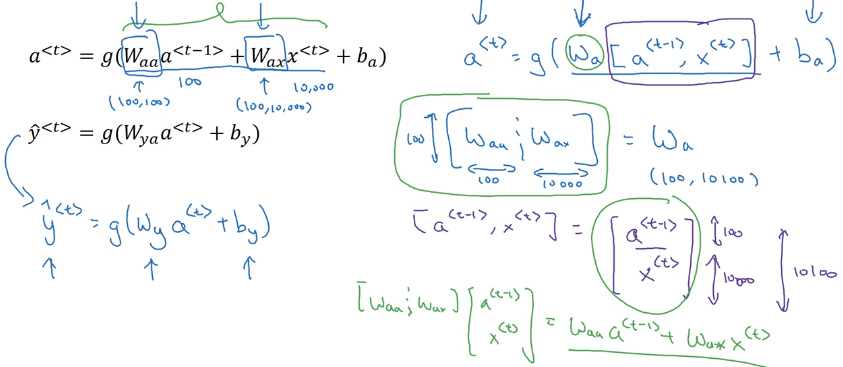
Backpropagation through time
Parameters: W_y and W_a
loss function: log loss at each timestep (assume predictions y

→ backporp through the computation graph:
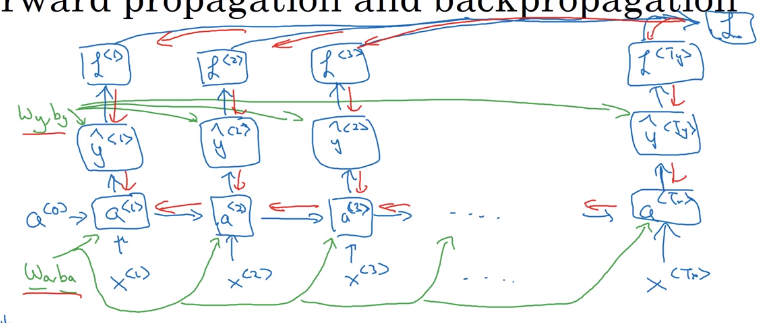
Different types of RNNs
many-to-many:
- T_x = T_y, one prediction per timestep.
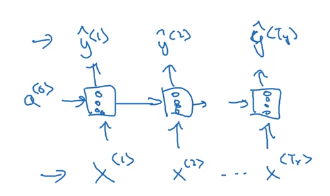
- T_x != T_y, e.g. machine translation
having a encoder and a decoder:
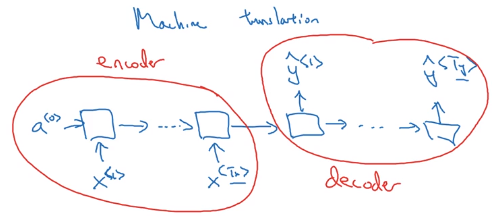
many-to-one:
e.g. sentence classification
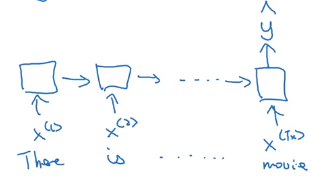
one-to-many:
e.g. music generation

Language model and sequence generation
Language model
motivation example: speech recognition,
"The apple and the pear salad" VS "The apple and the pair salad"
language model: give probability of a sentence P(sentence).
Building language model with RNN
Training set: large corpus of text.
- tokenize
- vocabulary size
- unknow word "
".
RNN for seq generation
- output
y<t>: softmax of probability for each word. y<t+1>: make prediction given the correct previous word- like this predict one word at a time.
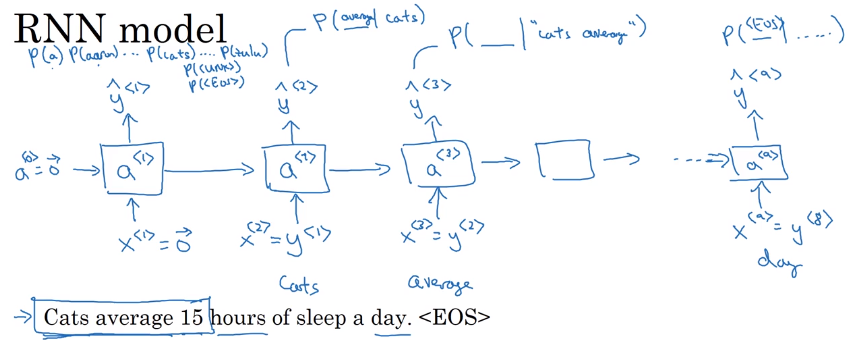
Loss function: cross entropy (actual word VS probability of this word) at each timestep.

Sampling novel sequences
Get a sense of what's learned: sample nouvel seqs.
From training, the RNN has a distribution of sequences P(y<t> | y<1...t-1>).
In sample: let the model generate sequences (np.random.choice):
- feed previously gen word as input to next step
- include
token in vocab to finish - reject
tokens
char-level language model

- pro: no
token - con: much longer sequences, more expensive to train.
Vanishing gradients with RNNs
long-range dependencies are hard to capture:
e.g. "the cat ........ was full" VS "the cats ...... were full"
this is due to vanishing gradients:
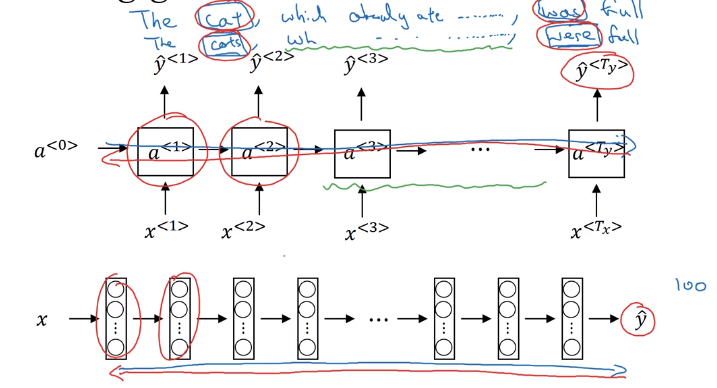
For exploding gradients: apply gradient clipping (restrict gradient norm).
Gated Recurrent Unit (GRU)
Modification of RNN to capture long range dependencies.
Visualization of a RNN unit:
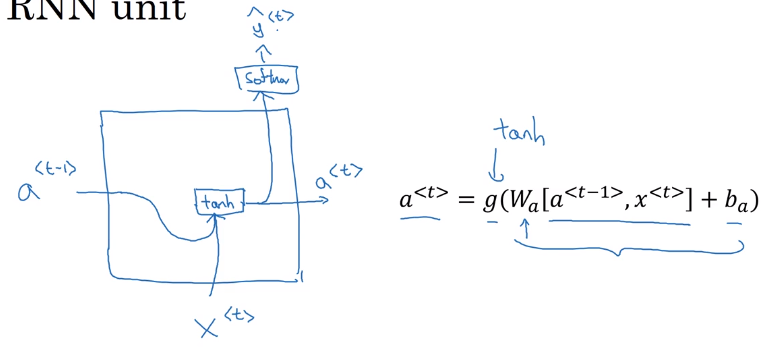
(simplified) GRU
- Extra memory cell:
c<t>=a<t>, (replaces output activation). - Candidate value of c
: c_tilde<t>=tanh(Wc * [c<t-1>, x<t>] + b_c) - Gate (between 0 and 1, conceptually consider it as binary):
Gamme_u = sigmoid(W_u * [c<t-1>, x<t>] + b_u)
subscript "u" stands for "update", i.e. whether we want to update current memory cell
- Actual value of
c<t> = Gamme_u * c_tilde<t> + (1-Gamma_u) * c<t-1>(*is element-wise multiplication)
i.e. c<t> can be conserved for long range before being updated
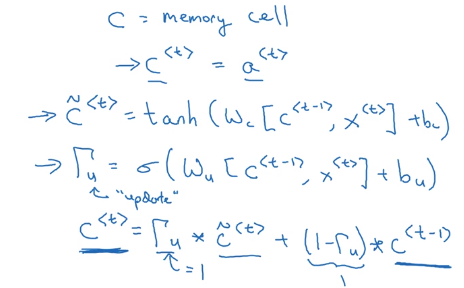
Visualization of GRU unit (maybe equations are more understandable...):
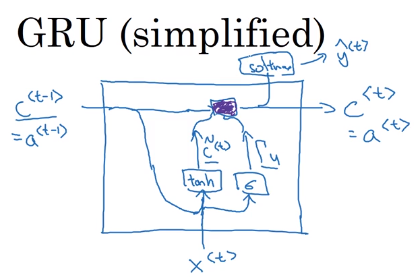
full GRU
for candidate c_tilde<t>, add one more gate Gamme_r: controlling how much c<t-1> contributes to c_tilde<t>("r" for "relevance", i.e. how relevant c<t-1> is for c_tilde<t>)
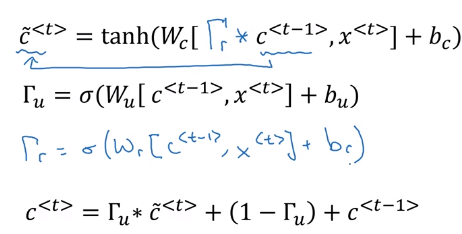
Long Short Term Memory (LSTM)
More powerful and general version of GRU.
- output
a<t>no longer equals to memory cellc<t>(but a gated version of it, see below) - candidate
c_tilde<t>depends ona<t-1>instead ofc<t-1> - two update gates:
Gamma_u(update gate) andGamma_f(forget gate) - output gate:
Gamma_o - value of
c<t> = Gamma_u * c_tilde<t> + Gamma_f * c<t-1> - value of
a<t> = Gamma_o * c<t>
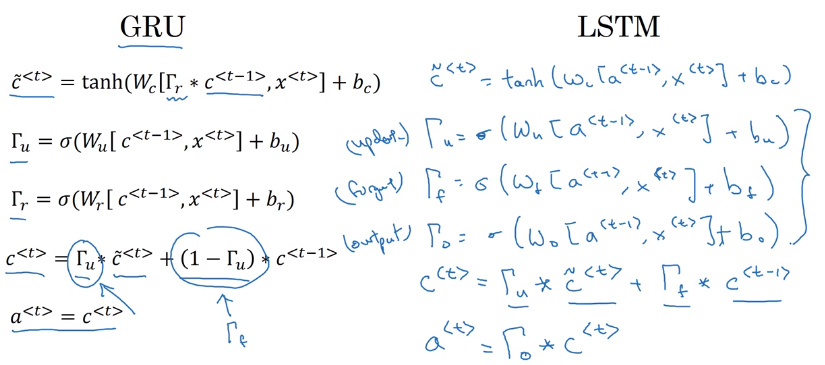
Visualization:
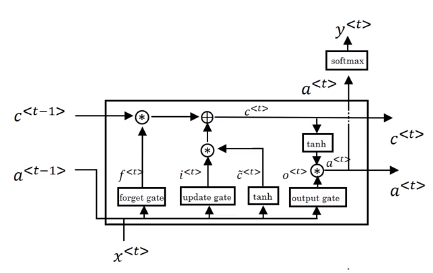
Intuition: c

Variant: let the gates depend on c
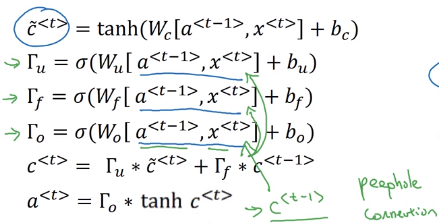
GRU vs LSTM
- LSTM is proposed earlier
- GRU as a simplified version of LSTM
- GRU easier to train larger NN (2 gates instead of 3)
- LSTM more powerful, recommended default choice to try
Bidirectional RNN
Getting information from the future.
motivation example:

Bidirectional RNN (BRNN)
- forward and backword recurrent components
- computation graph is still acyclic
- at t, both information from the past and the future are passed in
- BRNN with LSTM blocks are typically the first thing to try in NLP problems
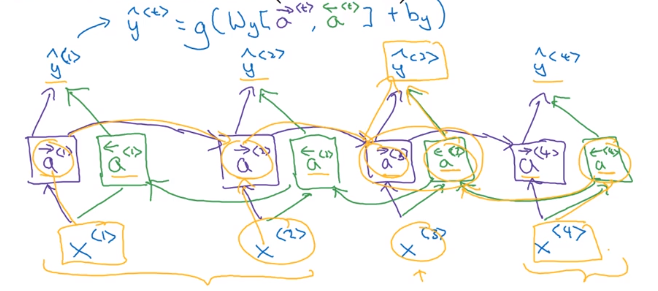
Deep RNNs
Complex NN: stack multiple RNNs (having 3 RNN layers is already a lot).0
notation: a[l]<t> for activation in layer l and time t.
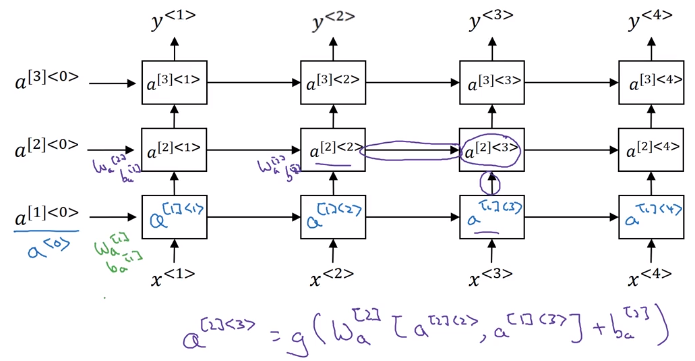
Part 14 of series «Andrew Ng Deep Learning MOOC»:
- [Neural Networks and Deep Learning] week1. Introduction to deep learning
- [Neural Networks and Deep Learning] week2. Neural Networks Basics
- [Neural Networks and Deep Learning] week3. Shallow Neural Network
- [Neural Networks and Deep Learning] week4. Deep Neural Network
- [Improving Deep Neural Networks] week1. Practical aspects of Deep Learning
- [Improving Deep Neural Networks] week2. Optimization algorithms
- [Improving Deep Neural Networks] week3. Hyperparameter tuning, Batch Normalization and Programming Frameworks
- [Structuring Machine Learning Projects] week1. ML Strategy (1)
- [Structuring Machine Learning Projects] week2. ML Strategy (2)
- [Convolutional Neural Networks] week1. Foundations of Convolutional Neural Networks
- [Convolutional Neural Networks] week2. Deep convolutional models: case studies
- [Convolutional Neural Networks] week3. Object detection
- [Convolutional Neural Networks] week4. Special applications: Face recognition & Neural style transfer
- [Sequential Models] week1. Recurrent Neural Networks
- [Sequential Models] week2. Natural Language Processing & Word Embeddings
- [Sequential Models] week3. Sequence models & Attention mechanism
Disqus 留言